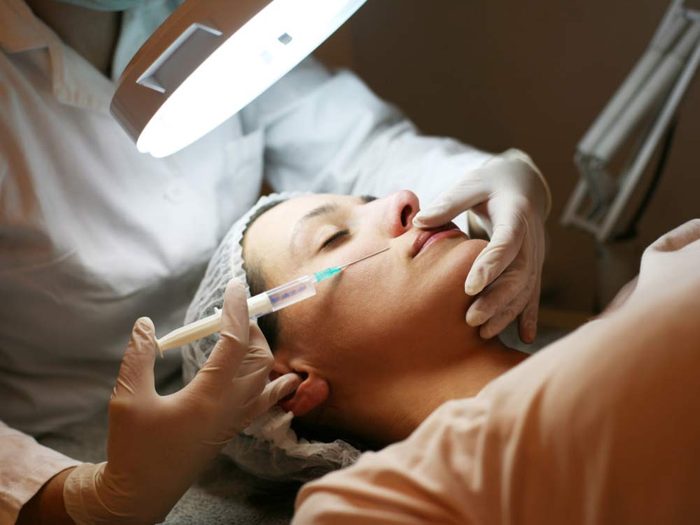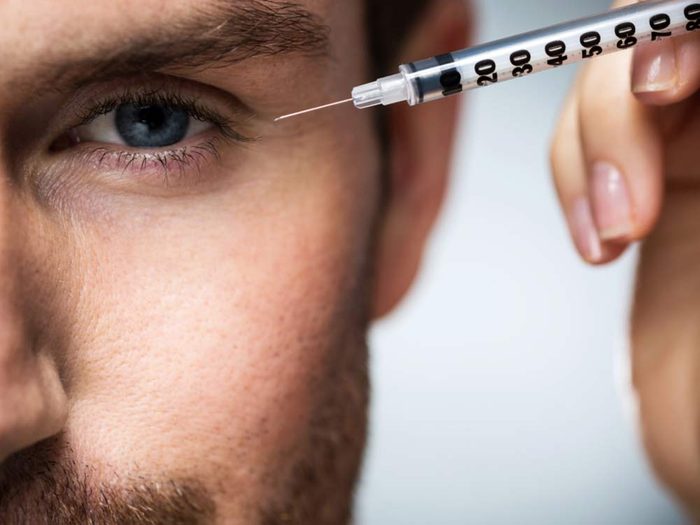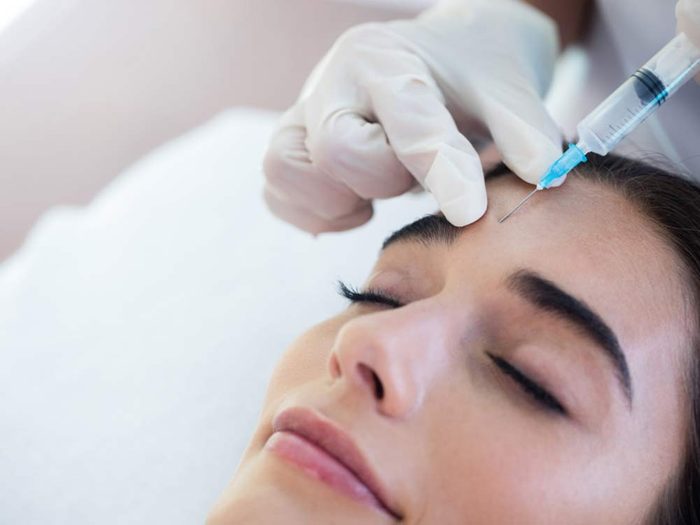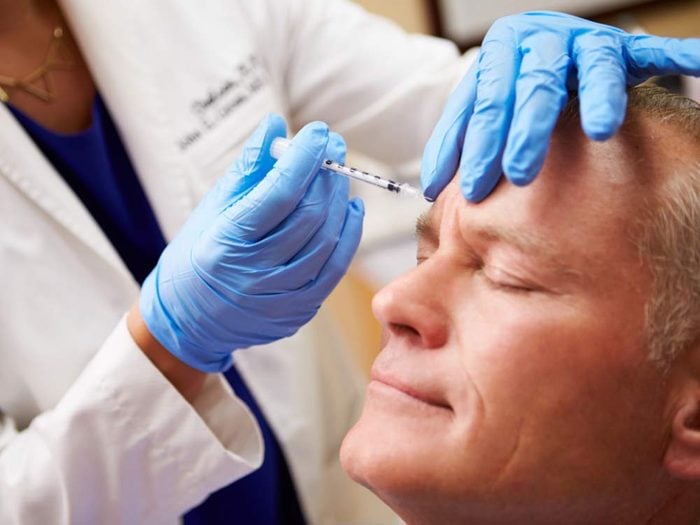
The Discovery of Botox
“There’s no putting the genie back in the bottle,” says Dr. Alastair Carruthers, named by The Observer as one of the “50 men who really understand women.” The genie is Botox, whose wrinkle-busting effects he and his wife, Jean, discovered in 1987. Since then, Botox has become a billion-dollar industry, North America’s No. 1 cosmetic procedure and the inspiration behind a crowded new generation of fillers, intense-pulsed-light and radio-frequency therapies, and other age-fighting products. This husband-and-wife team has played a major role in reshaping our notion of beauty.
Despite all this, the Botox founding legends are low-key. In 1987, Alastair divided his Vancouver dermatology practice between surgery for skin cancer and cosmetic procedures. He shared his office with Jean, an eye doctor who treated pediatric disorders as well as adult conditions such as blepharospasm. An uncontrollable blinking and spasming of the eye and surrounding area, blepharospasm was treated with a dilute solution of botulinum toxin, which, injected into the skin, temporarily paralyzes the spasming muscles. One day, by Jean’s account, one of her blepharospasm patients became irate that her forehead was not being injected. “But your forehead isn’t spasming,” Jean responded, and asked why she cared. “Because when you inject my forehead,” the patient said, “my wrinkles go away.”
At dinner that night, Jean mentioned to Alastair the woman’s reaction. He and his dermatology patients had been frustrated in their attempts to erase vertical frown lines between the eyebrows, known to doctors as “glabellar lines.” The fillers available at the time didn’t last long and could be painful. The next day, Jean talked their receptionist, Cathy Bickerton, into being the first guinea pig for the cosmetic use of botulinum toxin. Once Alastair saw the results, he needed no persuasion. “I had the patients,” he says, summing up what would become one of the most successful symbioses in late-20th-century cosmetic medicine, “and Jean had the toxin.”
Both expected the world to embrace their discovery. Instead, says Jean, the typical reaction was, “You want to inject what into my wrinkles?” At this point, Jean injected herself, whence her famous boast that she hasn’t frowned since 1987.
When they presented their results at the American Society for Dermatologic Surgery meeting in Orlando in 1991, she remembers, medical friends told them it was “a crazy idea that’s going nowhere.” But the Carrutherses continued conducting clinical trials—although it was difficult to find willing patients—and presenting their findings at dermatology meetings, watching their audiences slowly grow.
The snowball effect started in 1993. “Botox,” as the treatment was now called, began to sweep the world. Jean qualified as a cosmetic surgeon; she now does mostly head and neck procedures, and treats very few ophthalmological patients. Her husband stopped doing cancer surgery and now does full-body liposuction as well as head and neck cosmetic procedures.

The Doctors Behind Botox
As Jean leads me into her bright corner office in downtown Vancouver, I remember the last time I saw her, about 30 years ago. My daughter, then six, had an optical problem, and we were referred to a young pediatric-ophthalmologist in a dowdy office building. I remember her as taller and bigger than she is now, and not someone who paid much attention to fashion. I would never have twigged that this petite, chic woman was Carruthers, although I do recognize the light, rapid voice and the mid-Atlantic accent. I also recall that she had a nice way with my daughter, not condescending—and that her explanations to me were models of clarity.
No doubt she was already a rather unusual combination, a maternal superachiever. It’s still in evidence: She hugs her staff hello and goodbye daily, sends her patients birthday cards, brings bagels for medical students who shadow her, and loves to cook and entertain. The achiever part is not hard to explain. She was born Jean Elliott in Brandon, Man., to two English doctors who had immigrated after the Second World War. When her mother returned to England temporarily, she brought her two young daughters with her. The English sojourn, Jean says, was a turning point, giving her a taste for striving that has stayed with her. At 16 she went into honours chemistry at the University of British Columbia and she remained there for medical school. It was there she met Alastair, an English medical student who was doing an internship at the Vancouver General Hospital.
Born in Cheshire, England, in 1945, Alastair was also the child of a doctor father; his mother was a teacher. After meeting in Vancouver, he and Jean went to England to do their residencies, and married there in 1973. Jean became one of the first women to work at Moorfields, England’s premier eye hospital, and Alastair had a prestigious appointment at Hammersmith Hospital. They might have stayed in London’s stimulating medical atmosphere permanently, but consultants there worked until nine or ten at night. They wanted children and Vancouver promised a more balanced life. “We gave up the academic excellence of London for the whole family thing,” Alastair says, “and yet I think we’ve managed to do quite a lot.”

What is Botox?
An understatement. Since their concentration on cosmetic medicine, their hefty resumés now include more than 100 new articles in peer-reviewed medical journals, 60 book chapters and five textbooks. Travelling the world, they give about 30 talks a year to cosmetic and plastic surgeons and dermatologists. Their kingdom includes a research institute (in the same building as their offices) that coordinates their studies on new products and procedures. All told, they employ about ten people: nurses, researchers, administrators and patient-care coordinators.
Cosmetic medicine demands a personal touch. The doctor-patient bond in the cosmetic world, Jean says, lasts 30 to 40 years: “We’re talking about family.” The Carrutherses’ staff are crucial to this bond, and each doctor has a coordinator of patient care.
Jean says admiringly that the staff all look like “after” pictures. Before I can comment, she continues, “It’s important that all of us in the office are…I’m going to say ‘users.'” Staff are treated for free, since it’s to the Carrutherses’ benefit if everyone in the office not only looks good but is a source of reassurance.
Christa Campsall, a friendly, statuesque brunette who works as the clinic coordinator, agrees it’s much easier for her to put a patient at ease now that she’s had Botox and Restylane tissue fillers. When she started managing the clinic seven years ago, she was only 32, and the other staff would tease her, reminding Jean, “Christa’s still a Botox virgin.” She hadn’t been there long before she volunteered to be injected.
Jean Carruthers, at 61, is too canny not to understand that she herself is the main poster girl for their office. She’s matter-of-fact about the procedures she’s had: a complete facelift ten years ago, lid lifts, Botox, fillers, Thermage (a skin-tightening and skin-contouring treatment) and intense-pulsed-light treatments.
She’s also matter-of-fact about costs. Botox runs $16 a unit and most people require 30 units. Restylane, one of the best-known fillers, used for lip augmentation and for injection into wrinkles and facial folds, costs $600 a syringe (one millilitre); most patients require three or four syringes. Botox and the fillers, as well as the newer thermal treatments, all need to be repeated, sometimes every three or six months. Jean tells her patients, “Think of a nice handbag or several manicures.”
When I ask her if she thinks of Botox as a watershed in her career, or if she sees the last 35 years as a continuum, her answer is typically savvy: “It’s a continuum, because it’s all about the patients.” She sees herself as being in the business of restoring self-esteem. Like it or not, she says, we’re hard-wired to be attracted to beauty. Beautiful people earn more money, and people who look after their appearance have better cardiovascular health and live longer. Botox, she says, is “penicillin for self-esteem.”
Asked if she feels part of a climate that makes people unhappy about aging naturally, she answers, “What is aging naturally?” Then she adds, “It’s a choice.”
Cassandra, a patient of Jean’s, equates the procedures she’s had with exercising and taking her vitamins: “They are part of my wellness package, and psychological wellness is not to be underestimated.” She agrees there may be too much pressure to look young, but on the other hand, it’s better for a woman who’s been “kicked to the curb in a divorce” to be able to feel good about herself. A “workaholic professional,” Cassandra has a pleasant, unlined face and sunny blond hair cut in a pageboy. Had she not told me that she’s 56, I would have taken her to be in her late 20s.
Sydney, a makeup artist in his 50s who is a patient of Alastair’s, rattles off the fillers he’s used, names that shimmer with promise: Radiesse, Evolence, Juvéderm, Dermalive. “I’m plastic from the neck up!” he jokes, but adds, “I just want to maintain the way I was at 35.” A professional in what he calls a “youth-obsessed industry,” Sydney is a discriminating user, keeping his horizontal forehead lines because he wants to look expressive.
Here are 10 secrets to looking younger even your best friend doesn’t know.

Life After the Discovery
Most people assume that the Carrutherses’ discovery of Botox made them rich. True, their income has risen significantly now that they are concentrating on cosmetic medicine, but they didn’t patent Botox, so they haven’t reaped the rewards of its widespread cosmetic use. Alastair says, “We learned in med school that if you have an idea, you give it away.” And after 30 years of doing what he calls “straight medicine,” he feels he’s paid his dues: “I gave society back what it gave me in education.”
As for non-cosmetic doctors critical of his career shift-from saving lives to getting rid of wrinkles—Alastair has made his peace with that. He prefers thinking about all the research he and Jean have done to make cosmetic medicine “academically respectable.” When I ask him about being part of a sensibility that pushes people to try to stay young forever, he pauses. Finally, he says, “I think my job is to help people to be themselves.”
Scrutinizing me, he continues, “Right now, for example, I’m looking at Katherine, and I notice that she has highlights in her hair. Where do you draw the line between normal grooming and something else? Between wanting to look your best and something that’s too extreme?” It’s a good question.
As for Alastair himself, he’s had his frown lines and underarms Botoxed, and that’s it. Although “it hurts like hell,” having his underarms done, it means he doesn’t sweat while speaking in public. He injects the armpits of about ten per cent of his patients, including many teenagers, for that purpose.
“The holy grail for cosmetic medicine,” says Alastair, “is skin tightening in a simple, safe, effective manner.” He expects to see a Botox cream before too long. Jean also sees good things on the horizon—new neurotoxins will give Botox a run for its money, she believes, and fillers will be developed that don’t just fill in cracks but encourage skin tightening. Also, Thermage will get better at shrinking skin.
For the Carrutherses, who remain awesomely vigorous—they’re up by 5 a.m. to exercise in their home gym, and they’ve taken up golf and bicycling-the promise of new developments entices them more than retirement. Jean can’t imagine retiring: “I’m having too much fun.”